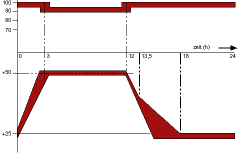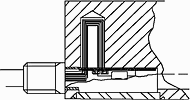
In the last article in this series, we looked at how to go about choosing load cells of the appropriate mass capacity, applying a de-rating to allow for shock loading, etc. Part II ended with a discussion on accuracy considerations. This month examines environmental considerations that significantly effect load cell installations.
Environmental protection
No area of load cell operation causes more confusion and contention than that of environmental protection and sealing standards. Although our industries have in-depth standards and test procedures to define load cell and weighing system performance, no standards have been developed to cover product suitability for specific environmental conditions. In the absence of such standards, most manufacturers have adopted the International Protection system (IP/IEC 529 or EN 40.050) or National Electrical Manufacturers Association Standards (NEMA publication 250). Define the level of sealing for their products. Both standards are good test procedures for environmental sealing when applied to the products for which they were intended - those being electrical enclosures, but they are not very well suited to load cells.
IP classification
The IP standard describes a system for classifying the degree of protection provided by the enclosures of electrical equipment.
* Protection of persons against access to hazardous parts inside the enclosure.
* Protection of the equipment inside the enclosure against the ingress of solid foreign objects.
* Protection of equipment inside the enclosure against harmful effects due to the ingress of water.
Unfortunately, no definition is given for the term 'harmful effects'. Presumably, for enclosures, the main problem with water could be one of electrical shock to persons in contact with the enclosure, rather than malfunctioning of the unit. Furthermore, the standard only relates to water ingress and ignores moisture, chemicals, corrosion, etc.
The commonly used categories to describe load cell sealing are:
* IP65 protected against low pressure jets of water from all directions, limited entrance allowed.
* IP66 protected against strong jets of water, eg for use on ship decks, limited entrance allowed.
* IP67 protected against the effects of immersion between 15 cm and 1 m.
* IP68 Protected against long periods of immersion under pressure.
NEMA Classification Classifications in the NEMA system run from NEMA 1 to NEMA 12, but load cell manufacturers concern themselves with NEMA 4 and NEMA 6. Unlike the IP system, NEMA does concern itself with environmental conditions such as corrosion, rust, freezing, oil and coolants. NEMA 4 enclosures are intended for indoor and outdoor use, providing a degree of protection against windblown dust, rain, splashing water, and hose directed water. However, no consideration is given for the effects of internal condensation. Nema 4X enclosures meet the same standards as NEMA 4 and are constructed of 304 stainless steel or other material offering equal corrosion resistance.
NEMA 6 enclosures are used where there is a chance of temporary immersion. This standard calls for the highest part of the enclosure to remain submerged in water, with its highest point 1,83 m below the surface for 30 minutes. NEMA 6P enclosures are used where prolonged immersion may occur and resistance to corrosion is needed.
While it may seem that NEMA standards offer some advantages over the IP system for corrosion resistance, they only relate to external corrosion of enclosures. This is very limited when applied to the more complex load cell construction and the different effects of corrosion or water ingress. 1.4.3
Damp Heat Cycling (IEC 68-2-30)
The IP and NEMA standards do not deal with internal condensation or moisture within the enclosure. However, moisture or condensation is of vital importance in correct load cell operation.
Moisture may enter the inside of the load cell over a long period and have a catastrophic effect, especially when acids or alkalis are present. One test used to determine a load cells ability to withstand moisture or condensation is the damp heat cycling test. The object of the IEC standard is 'To determine the suitability of components, equipment, or other articles for use and storage under conditions of high humidity when combined with cyclical temperature changes'.
It is obvious that this standard is a much more useful classification than the IP or NEMA rating when it comes to defining load cell environmental suitability.

Load cell construction
Besides a given IP-rating or NEMA-classification, load cells should also be classified according to their design in terms of cable entry, material of construction and gauges sealing method.
Whilst it is relatively common to weld-seal critical areas on a load cell body, one potential problem area is the cable entry. A variety of methods are used to make sure cells are properly sealed at this area.
In most load cells the main cable enters through a conventional cable gland directly into the gauge area. Regardless of how well the gauge area is sealed, moisture and solvents can penetrate either around the gland or through the centre of the cable itself. Often, temperature changes cause a pumping action to occur, pushing moisture down the inside of the cable. Entry also can be via a leaking junction box or through a damaged part of the cable. This can take some time to reach critical areas, but once there it will become sealed in place and do critical damage.

An improvement on the basic cable gland is a water block at the point of cable entry. Here, the main cable terminates at for example a small circuit board with on-going wires leading to the gauge area. The block is fully potted to prevent moisture or other contaminants from reaching the critical areas.
The best solution is the use of a glass-to-metal cable entrance. This prevents any contamination from reaching the gauge or other critical areas. In addition, the manufacturing process used must keep the load cell free from residue contaminations. Purging the internal cavity with helium usually solves any problem with residuals. Revere Transducers model RLC is first filled with helium, which allows leaks to be found with conventional leak detection equipment and just before closing the load cell the helium is replaced with argon.
Corrosion
The corrosion resistance of load cells is a very complex subject, one that is further complicated by the variety of available configurations. As a result it is only possible to use standard corrosion charts as guidance for load cells. In addition, the following factors must be considered:
* Surface finish.
* Weld areas around seals, bellows and cups.
* Thickness of seals.
* Varying construction materials.
* High stress levels at loading points.
* Cable material (PVC, PUR or Teflon).
The environment itself plays an important role in how a particular load cell type behaves in practice. Salt water, for example, has different corrosion effects depending on the local circumstances. Stainless steel in stagnant salt water is subject to crevice corrosion and a regular wash down is necessary to avoid degradation.
Unfortunately the term stainless steel has become synonymous with 'no corrosion, no problem and no maintenance'. While stainless steel load cells usually offer optimum protection in most environments, other factors should be taken into account. In certain applications, painted or plated load cells may offer better long-term protection. An alternative is wrap-around protective covers. These can provide good environmental protection, but can be self-destructive if corrosive material is trapped inside the cover.
Summary
Selecting the wrong load cell for an application in terms of environmental compatibility can have far reaching consequences in terms of costs, safety and product reputation. Current classifications fall well short of defining adequate environmental standards for load cells. The users should compare like-for-like features when selecting products from different manufacturers. If in doubt, they should ask pertinent questions relating to:
* Construction of the load cell.
* Cable entry method.
* Past experiences.
For applications in harsh environments, additional protection for the load cells may be needed to assure their reasonable working life. This can be achieved with enhanced scale designs and the use of additional coatings on the load cell, such as paints, greases and plating. The scale or system design should minimise the possibility of material build-up around the cells. If appropriate, the design should also provide mechanical protection from the effects of direct water and solvents whilst cleaning. Sealing compounds and rubbers used on some load cells can deteriorate when exposed to chemicals or direct sunlight. Chlorine-based compounds are a particular problem, as they cause rubber to become brittle.
| Tel: | +27 10 595 1831 |
| Email: | [email protected] |
| www: | www.instrotech.co.za |
| Articles: | More information and articles about Instrotech |

© Technews Publishing (Pty) Ltd | All Rights Reserved